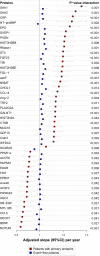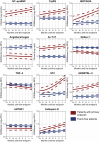Machine learning-based biomarker profile derived from 4210 serially measured proteins predicts clinical outcome of patients with heart failure
- PMID: 38045440
- PMCID: PMC10689916
- DOI: 10.1093/ehjdh/ztad056
Machine learning-based biomarker profile derived from 4210 serially measured proteins predicts clinical outcome of patients with heart failure
Abstract
Aims: Risk assessment tools are needed for timely identification of patients with heart failure (HF) with reduced ejection fraction (HFrEF) who are at high risk of adverse events. In this study, we aim to derive a small set out of 4210 repeatedly measured proteins, which, along with clinical characteristics and established biomarkers, carry optimal prognostic capacity for adverse events, in patients with HFrEF.
Methods and results: In 382 patients, we performed repeated blood sampling (median follow-up: 2.1 years) and applied an aptamer-based multiplex proteomic approach. We used machine learning to select the optimal set of predictors for the primary endpoint (PEP: composite of cardiovascular death, heart transplantation, left ventricular assist device implantation, and HF hospitalization). The association between repeated measures of selected proteins and PEP was investigated by multivariable joint models. Internal validation (cross-validated c-index) and external validation (Henry Ford HF PharmacoGenomic Registry cohort) were performed. Nine proteins were selected in addition to the MAGGIC risk score, N-terminal pro-hormone B-type natriuretic peptide, and troponin T: suppression of tumourigenicity 2, tryptophanyl-tRNA synthetase cytoplasmic, histone H2A Type 3, angiotensinogen, deltex-1, thrombospondin-4, ADAMTS-like protein 2, anthrax toxin receptor 1, and cathepsin D. N-terminal pro-hormone B-type natriuretic peptide and angiotensinogen showed the strongest associations [hazard ratio (95% confidence interval): 1.96 (1.17-3.40) and 0.66 (0.49-0.88), respectively]. The multivariable model yielded a c-index of 0.85 upon internal validation and c-indices up to 0.80 upon external validation. The c-index was higher than that of a model containing established risk factors (P = 0.021).
Conclusion: Nine serially measured proteins captured the most essential prognostic information for the occurrence of adverse events in patients with HFrEF, and provided incremental value for HF prognostication beyond established risk factors. These proteins could be used for dynamic, individual risk assessment in a prospective setting. These findings also illustrate the potential value of relatively 'novel' biomarkers for prognostication.
Clinical trial registration: https://clinicaltrials.gov/ct2/show/NCT01851538?term=nCT01851538&draw=2&rank=1 24.
Keywords: Elastic net; Heart failure; NT-proBNP; Prediction; Proteomics; Repeated measurements.
© The Author(s) 2023. Published by Oxford University Press on behalf of the European Society of Cardiology.
Conflict of interest statement
Conflict of interest: R.O. is employed by Somalogic Inc. D.L. reports non-financial support from Somalogic Inc., during the conduct of the study; grants and personal fees from Janssen, personal fees from Ortho Diagnostics, personal fees from DCRI (Novartis), grants from Bayer, grants from Astra Zeneca, grants from Critical Diagnostics, non-financial support from Somalogic, grants from Lilly, personal fees from ACI (Abbott Laboratories), personal fees from Martin Pharmaceuticals, personal fees from Illumina, personal fees from Vicardia, other from Hridaya, grants and personal fees from Amgen, personal fees from Cytokinetics, outside the submitted work. In addition, D.L. has a patent genomic predictors of BB response issued. The other authors have no disclosures to report.
Figures



Similar articles
-
Dynamic personalized risk prediction in chronic heart failure patients: a longitudinal, clinical investigation of 92 biomarkers (Bio-SHiFT study).Sci Rep. 2022 Feb 18;12(1):2795. doi: 10.1038/s41598-022-06698-3. Sci Rep. 2022. PMID: 35181700 Free PMC article. Clinical Trial.
-
Sex-based differences in cardiovascular proteomic profiles and their associations with adverse outcomes in patients with chronic heart failure.Biol Sex Differ. 2023 May 17;14(1):29. doi: 10.1186/s13293-023-00516-9. Biol Sex Differ. 2023. PMID: 37198662 Free PMC article.
-
Proteomic biomarkers related to obesity in heart failure with reduced ejection fraction and their associations with outcome.Obesity (Silver Spring). 2024 Sep;32(9):1658-1669. doi: 10.1002/oby.24094. Epub 2024 Jul 22. Obesity (Silver Spring). 2024. PMID: 39039788
-
Validation of the MAGGIC (Meta-Analysis Global Group in Chronic Heart Failure) heart failure risk score and the effect of adding natriuretic peptide for predicting mortality after discharge in hospitalized patients with heart failure.PLoS One. 2018 Nov 28;13(11):e0206380. doi: 10.1371/journal.pone.0206380. eCollection 2018. PLoS One. 2018. PMID: 30485284 Free PMC article.
-
The role of N-terminal pro-B-type natriuretic peptide in prognostic evaluation of heart failure.J Chin Med Assoc. 2019 Jun;82(6):447-451. doi: 10.1097/JCMA.0000000000000102. J Chin Med Assoc. 2019. PMID: 31180944 Review.
Cited by
-
Modulation of metabolic, inflammatory and fibrotic pathways by semaglutide in metabolic dysfunction-associated steatohepatitis.Nat Med. 2025 Jul 21. doi: 10.1038/s41591-025-03799-0. Online ahead of print. Nat Med. 2025. PMID: 40691365
-
Methods for joint modelling of longitudinal omics data and time-to-event outcomes: Applications to lysophosphatidylcholines in connection to aging and mortality in the Long Life Family Study.medRxiv [Preprint]. 2024 Jul 30:2024.07.29.24311176. doi: 10.1101/2024.07.29.24311176. medRxiv. 2024. Update in: Aging (Albany NY). 2025 May 27;17(5):1221-1260. doi: 10.18632/aging.206259. PMID: 39132492 Free PMC article. Updated. Preprint.
-
Methods for joint modeling of longitudinal omics data and time-to-event outcomes: applications to lysophosphatidylcholines in connection to aging and mortality in the Long Life Family Study.Aging (Albany NY). 2025 May 27;17(5):1221-1260. doi: 10.18632/aging.206259. Epub 2025 May 27. Aging (Albany NY). 2025. PMID: 40440492 Free PMC article.
-
Identifying plasma proteomic signatures from health to heart failure, across the ejection fraction spectrum.Sci Rep. 2024 Jun 27;14(1):14871. doi: 10.1038/s41598-024-65667-0. Sci Rep. 2024. PMID: 38937570 Free PMC article.
-
Emerging roles for the ADAMTS-like family of matricellular proteins in cardiovascular disease through regulation of the extracellular microenvironment.Mol Biol Rep. 2024 Feb 7;51(1):280. doi: 10.1007/s11033-024-09255-5. Mol Biol Rep. 2024. PMID: 38324186 Free PMC article. Review.
References
-
- McDonagh TA, Metra M, Adamo M, Gardner RS, Baumbach A, Böhm M, et al. 2021 ESC guidelines for the diagnosis and treatment of acute and chronic heart failure: developed by the task force for the diagnosis and treatment of acute and chronic heart failure of the European Society of Cardiology (ESC) with the special contribution of the Heart Failure Association (HFA) of the ESC. Eur Heart J 2021;42:3599–3726. - PubMed
-
- Heidenreich PA, Bozkurt B, Aguilar D, Allen LA, Byun JJ, Colvin MM, et al. 2022 AHA/ACC/HFSA guideline for the management of heart failure: a report of the American College of Cardiology/American Heart Association Joint Committee on Clinical Practice Guidelines. J Am Coll Cardiol 2022;79:e263–e421. - PubMed
-
- Chow SL, Maisel AS, Anand I, Bozkurt B, de Boer RA, Felker GM, et al. Role of biomarkers for the prevention, assessment, and management of heart failure: a scientific statement from the American Heart Association. Circulation 2017;135:e1054–e1091. - PubMed
Associated data
LinkOut - more resources
Full Text Sources
Medical
Research Materials
Miscellaneous
